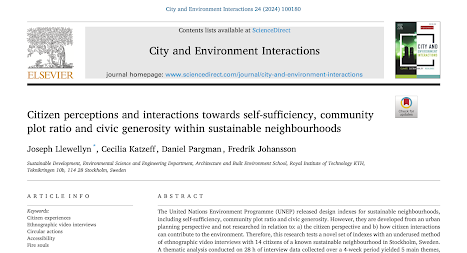.
I am the co-supervisor of ph.d. student Joe Llewellyn and he just got his second article published, "
Assessing the impact of energy coaching with smart technology interventions to alleviate energy poverty". It's published in the journal Scientific Reports (published by Nature Publishing Group (now called Nature Portfolio)). Joe's main supervisor is my colleague Cecilia Katzeff and he in fact also has a third supervisor, Fredrik Johansson.

Scientific Reports (established in 2011) is a "peer-reviewed, open-access scientific mega journal covering all areas of the natural sciences" and "In September 2016, the journal became the largest in the world by number of articles" (both quotes from
Wikipedia).
According to themselves, "Scientific Reports is the 5th most-cited journal in the world". So I think it's kind of a big thing. It's also a big study and the image above illustrates where in Amsterdam the 117 (!) homes that Joe visited are located. And
besides these 117 homes, Joe
revisited 73 of them again for a total of 190 home visits.
Joe did this study together with Senseable City Lab (three of the authors are from there) in Amsterdam. Since there is a strong link between the lab and MIT (fourth author Carlo Ratti, who is a faculty member at MIT, founded and directs the Senseable City Lab), the best way to understand what Joe's article is about is to read the popular science
write-up by MIT News. It starts like this:
"Many people around the globe are living in energy poverty, meaning they spend at least 8 percent of their annual household income on energy. Addressing this problem is not simple, but an experiment by MIT researchers shows that giving people better data about their energy use, plus some coaching on the subject, can lead them to substantially reduce their consumption and costs.
The experiment, based in Amsterdam, resulted in households cutting their energy expenses in half, on aggregate — a savings big enough to move three-quarters of them out of energy poverty.
“Our energy coaching project as a whole showed a 75 percent success rate at alleviating energy poverty,” says Joseph Llewellyn, a researcher with MIT’s Senseable City Lab and co-author of a newly published paper detailing the experiment’s results."
Besides MIT Senseable City Lab and KTH, other organisations involved in the study were the City of Amsterdam, the Amsterdam Institute for Advanced Metropolitan Solutions (AMS Insitute) and Stichting !WOON (an independent, non-profit foundation).
However, besides this article, Joe also got his first article, "Citizen perceptions and interactions towards self-sufficiency, community plot ratio and civic generosity within sustainable neighbourhoods", published only a month ago in the journal "City and Environment Interactions". Cecilia Katzeff, me and Fredrik Johansson are again co-authors.
This was the study Joe did (almost) two years ago in Hammarby Sjöstad in Stockholm (see map below), before Joe went to Amsterdam to the study of how to alleviate energy poverty. The paper would ideally have been published before Joe went to Amsterdam, but it was delayed for various reasons. So it has taken a long time for Joe to get his research published, but now he's on fire!
Congratulations Joe for getting both of these articles published!
Side note: as it so happens, I'm in The Netherlands at the moment and will go to Amsterdam tomorrow and meet up with Joe. Why am I in The Netherlands? That's the topic of my next blog post...
Abstract (paper 1)
Energy poverty affects 550,000 homes in the Netherlands yet policy interventions to alleviate this issue are rare. Therefore, we test two energy coaching interventions in Amsterdam: a static information group (n = 67) which received energy efficient products and one energy-use report, and a smart information group (n = 50), which also had a display providing real-time feedback on energy-use. Results across both groups, show a 75% success rate for alleviating energy poverty. On average homes reduced monthly electricity consumption by 62 kWh (33%), gas by 41 m3 (42%), bills by €104 (53%) and percentage of income spent on energy from 10.1% to 5.3%.
Abstract (paper 2)
The United Nations Environment Programme (UNEP) released design indexes for sustainable neighbourhoods, including self-sufficiency, community plot ratio and civic generosity. However, they are developed from an urban planning perspective and not researched in relation to: a) the citizen perspective and b) how citizen interactions can contribute to the environment. Therefore, this research tests a novel set of indexes with an underused method of ethnographic video interviews with 14 citizens of a known sustainable neighbourhood in Stockholm, Sweden. A thematic analysis conducted on 28 h of interview data collected over a 4-week period yielded 5 main themes, from outdoor public spaces. Self-sufficiency findings suggest that citizens 1) perceive small scale self-sufficiency to be challenged by large scale structural efficiency and 2) circular actions with food waste to biogas can develop the self-sufficiency index further. Community plot ratio findings suggest that citizens 3) perceive community spaces to be accessible for all but not used by all. Civic generosity findings suggest citizens 4) perceive an imbalance between self-interests of the individual versus collective interests of the community, while 5) experienced citizens feel personally responsible to pioneer civic generosity interactions. UNEP indexes for designing neighbourhoods can define local sustainability, however, our findings support this, only if they can be acted upon by the citizens who live there.
.





Inga kommentarer:
Skicka en kommentar